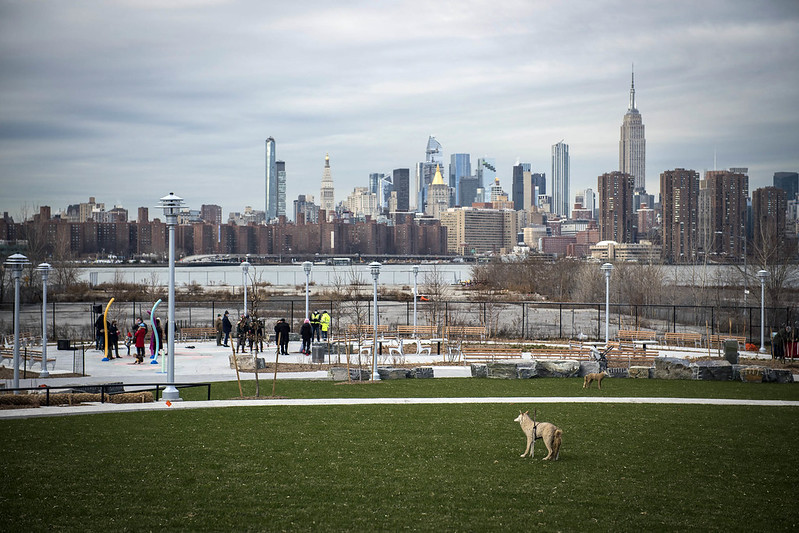
New park investments (photo: Ed Reed/Mayoral Photography Office)
New York took a big step forward last month when Governor Hochul and Mayor Adams released Making New York Work for Everyone, a plan with 40 commitments meant to steer New York City toward economic growth and livability. The report sets goals and policies for reinvigorating the city’s commercial corridors and fostering vibrancy by addressing commute times, housing, public space, outdoor dining, and more. But even more promising than the individual commitments is the clear acknowledgement that people-centered policy and placemaking is at the heart of New York City’s future.
As members of the Alliance for Public Space Leadership, we’ve been advocating for this exact progress. Our public spaces — parks, plazas, streets, sidewalks — are the lifeblood of this city. But great public spaces have too often been reserved for wealthier neighborhoods, and haven’t been prioritized as essential pieces of a healthy and thriving city for all.
As a coalition, we want government leaders to understand that these public spaces need central investment in the same way as other public services. Currently, there is no holistic management or investment in New York’s public space. Every Open Street, block party, or neighborhood safety initiative is the product of intense volunteer effort, organization, and coordination. It’s inequitable, exclusionary, and burdensome. And within government, city agencies and departments are too often working in isolation. They can’t focus on collaborative problem-solving because our government structure doesn’t allow for it.
That’s why the new report is so promising. For the first time, New York City is acknowledging the need for structural and holistic leadership with a new Director of the Public Realm. This central decision-maker can help envision the city’s public spaces as part of a larger ecosystem — one that impacts physical health, mental wellbeing, sense of community, economic success, and climate resilience.
Our Director of the Public Realm should provide communities with the resources they need to cultivate Open Streets and other street activations, prioritize equitable access to public space in underserved neighborhoods, and provide design leadership to ensure our public space is high-quality and sustainable. This is our chance to build New York City’s first overarching vision for public space.
The 59 ‘New’ New York panelists who wrote this report (and we were glad to meet with during their research phase) have recognized that economic growth doesn’t happen in a bubble. Commerce is connected with place and people, as the recent Streetscapes for Wellness and Streets for Recovery reports have shown. When New Yorkers have safe, reliable, and joyful space in their neighborhoods, they support local business. When curb lanes are used for things other than car storage, bus commutes get shorter and neighborhoods become more livable. When we give communities the tools to build inclusive, communal space in their neighborhoods, everyone benefits.
These aren’t just nice ideas, they’re proven solutions to a better future.
New York City has made a bold step here, but there’s still a long road ahead. We will need everyone’s support and commitment in fulfilling the 40 goals in this report and moving beyond pandemic recovery into a bright, thriving, and equitable future.
Our alliance has joined forces to advocate for shared space and shared goals; we’ve found strength in our numbers. Now, New York City’s leaders at all three levels of government must do the same. To reimagine New York’s business districts — and every district — as vibrant, 24/7 destinations, we’ll need local officials to prioritize people over cars. We’ll need leaders with vision who will catalyze a new future, not a return to the way things were. The siloed status quo is harmful to the wellbeing of our city’s residents, particularly those in underserved communities. It isolates public space in wealthier communities, strips New Yorkers of their ability to create inclusive spaces, and creates dangerous street conditions where thriving public space could be. We must move beyond that. We must think cooperatively about our shared spaces to arrive at shared solutions.
As an alliance, we’re committed to pushing the city forward, helping to illuminate the possibilities and solutions for a brighter future. We’re energized to see the Adams administration commit to do the same. We’re looking forward to working with the city’s first Director of the Public Realm, and all our decision-makers, on the exciting road ahead.
***
Elizabeth Goldstein, President, The Municipal Art Society of New York. @MASNYC
Jackson Chabot, Director of Advocacy and Organization, Open Plans. @OpenPlans
Benjamin Prosky, Executive Director, American Institute of Architects (AIA) New York. @AIA_NewYork
Adam Ganser, Executive Director, New Yorkers for Parks. @NY4P
***
Have an op-ed idea or submission for Gotham Gazette? Email This email address is being protected from spambots. You need JavaScript enabled to view it.